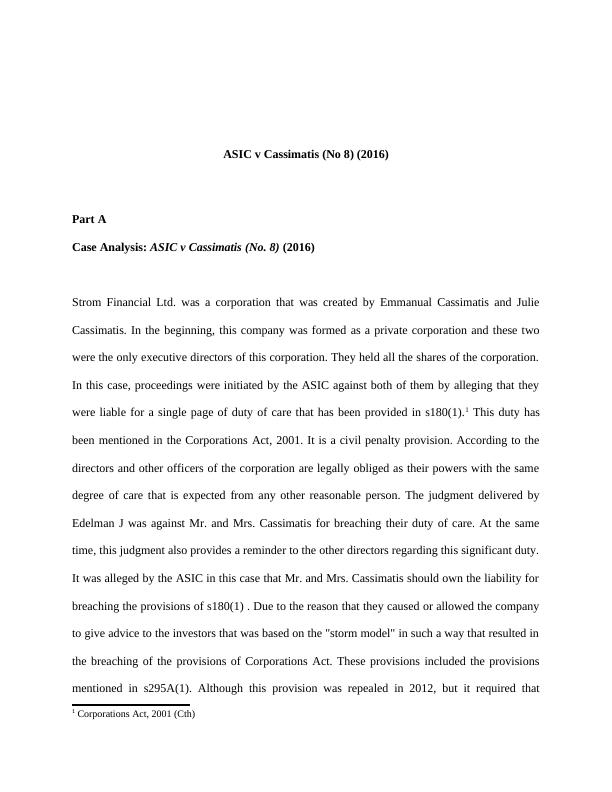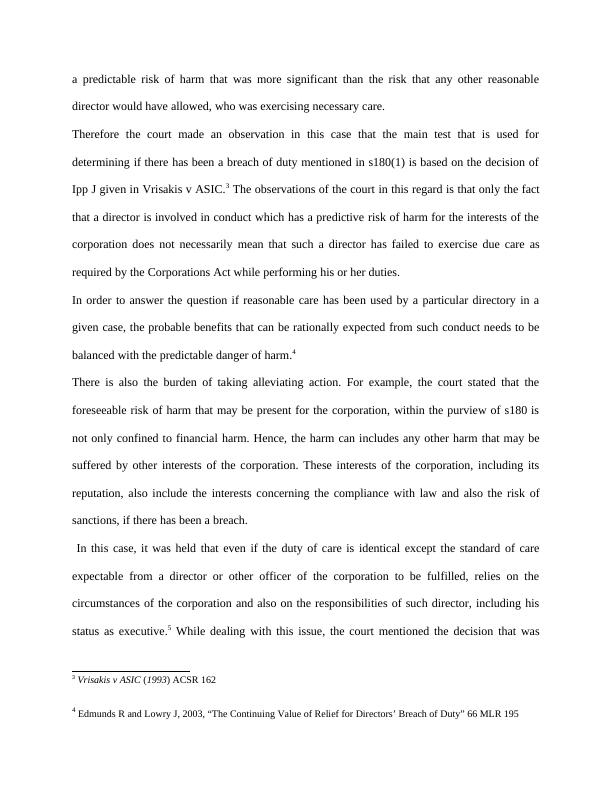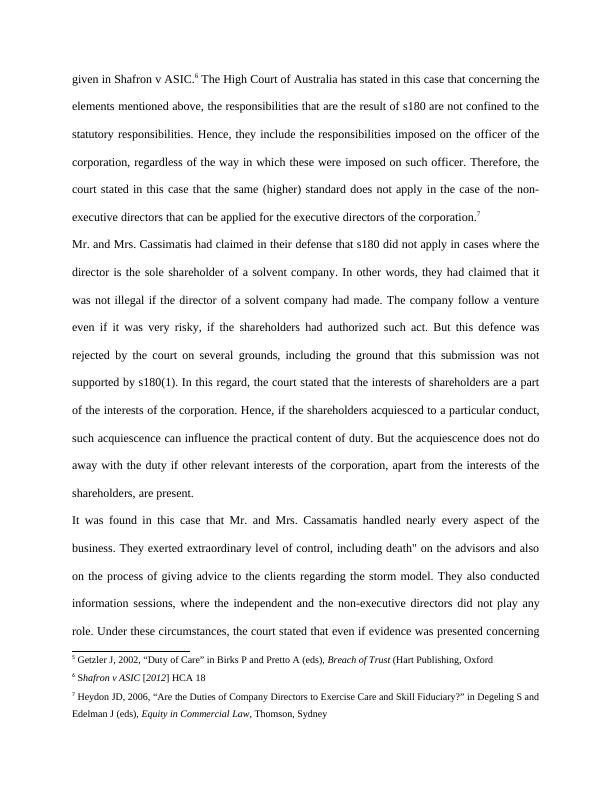LAWS19032 Company & Association Law - CQU
13 Pages3441 Words66 Views
Central Queensland University
Company Law (LAWS19032)
Added on 2020-03-02
About This Document
LAWS19032 - The following document is based on Company and Association law. The first case analysis of the paper is ASIC v Cassimatis.
LAWS19032 Company & Association Law - CQU
Central Queensland University
Company Law (LAWS19032)
Added on 2020-03-02
ShareRelated Documents
ASIC v Cassimatis (No 8) (2016)Part ACase Analysis: ASIC v Cassimatis (No. 8) (2016) Strom Financial Ltd. was a corporation that was created by Emmanual Cassimatis and JulieCassimatis. In the beginning, this company was formed as a private corporation and these twowere the only executive directors of this corporation. They held all the shares of the corporation.In this case, proceedings were initiated by the ASIC against both of them by alleging that theywere liable for a single page of duty of care that has been provided in s180(1).1 This duty hasbeen mentioned in the Corporations Act, 2001. It is a civil penalty provision. According to thedirectors and other officers of the corporation are legally obliged as their powers with the samedegree of care that is expected from any other reasonable person. The judgment delivered byEdelman J was against Mr. and Mrs. Cassimatis for breaching their duty of care. At the sametime, this judgment also provides a reminder to the other directors regarding this significant duty.It was alleged by the ASIC in this case that Mr. and Mrs. Cassimatis should own the liability forbreaching the provisions of s180(1) . Due to the reason that they caused or allowed the companyto give advice to the investors that was based on the "storm model" in such a way that resulted inthe breaching of the provisions of Corporations Act. These provisions included the provisionsmentioned in s295A(1). Although this provision was repealed in 2012, but it required that1 Corporations Act, 2001 (Cth)

financial services licensees like the present Corporation to give advice to their clients only if :-tothe information provided by the client regarding the particular situation, the entity giving theadvise has inquired regarding the subject matter to such an extent that can be termed asreasonable (s945A(1)(b)) and it can also be stated that the advise was appropriate for the blind,due to such consideration and investigation by the entity (945A(1)(c)). While delivering the judgment, the court pointed out towards the fact that a high bar is providedby ASIC, while deciding the liability that the court was concerned, if it was necessary to have areal breach by the Corporation in order to claim that s180(1) has been breached. Keeping in viewthe particular investors on whom the ASIC had finally rested its case, were retired persons orpersons who were shortly going to retire.2 The result was that such persons were particularlyvulnerable to loss as they had very few assets and small income apart from their family homesand a restricted superannuation.On the other hand, the Storm model of investment on which Mr. and Mrs. Cassimatis had reliedinvolved the concept of borrowing for the purpose of investing such money for a term of fiveyears or even more. This strategy was supplied by one witness as double gearing. Hence,according to this model, the investors borrowed money keeping their homes as security, got amargin loan and this amount for investing in index funds, creating cash reserve, and also forpaying the fee of the corporation.At the same time, the ASIC also made an allegation, that Mr. and Mrs. Cassimatis had allowedall caused their employees to give advise in such a way that resulted in the contravention of theprovisions of the Corporations Act by the company and by doing so they made the company face2 Edmunds R and Lowry J, 2002 “Excuses” in P Birks and Pretto A (eds), Breach of Trust (Hart Publishing)

a predictable risk of harm that was more significant than the risk that any other reasonabledirector would have allowed, who was exercising necessary care. Therefore the court made an observation in this case that the main test that is used fordetermining if there has been a breach of duty mentioned in s180(1) is based on the decision ofIpp J given in Vrisakis v ASIC.3 The observations of the court in this regard is that only the factthat a director is involved in conduct which has a predictive risk of harm for the interests of thecorporation does not necessarily mean that such a director has failed to exercise due care asrequired by the Corporations Act while performing his or her duties.In order to answer the question if reasonable care has been used by a particular directory in agiven case, the probable benefits that can be rationally expected from such conduct needs to bebalanced with the predictable danger of harm.4There is also the burden of taking alleviating action. For example, the court stated that theforeseeable risk of harm that may be present for the corporation, within the purview of s180 isnot only confined to financial harm. Hence, the harm can includes any other harm that may besuffered by other interests of the corporation. These interests of the corporation, including itsreputation, also include the interests concerning the compliance with law and also the risk ofsanctions, if there has been a breach. In this case, it was held that even if the duty of care is identical except the standard of careexpectable from a director or other officer of the corporation to be fulfilled, relies on thecircumstances of the corporation and also on the responsibilities of such director, including hisstatus as executive.5 While dealing with this issue, the court mentioned the decision that was3Vrisakis v ASIC (1993) ACSR 1624 Edmunds R and Lowry J, 2003, “The Continuing Value of Relief for Directors’ Breach of Duty” 66 MLR 195

given in Shafron v ASIC.6 The High Court of Australia has stated in this case that concerning theelements mentioned above, the responsibilities that are the result of s180 are not confined to thestatutory responsibilities. Hence, they include the responsibilities imposed on the officer of thecorporation, regardless of the way in which these were imposed on such officer. Therefore, thecourt stated in this case that the same (higher) standard does not apply in the case of the non-executive directors that can be applied for the executive directors of the corporation.7Mr. and Mrs. Cassimatis had claimed in their defense that s180 did not apply in cases where thedirector is the sole shareholder of a solvent company. In other words, they had claimed that itwas not illegal if the director of a solvent company had made. The company follow a ventureeven if it was very risky, if the shareholders had authorized such act. But this defence wasrejected by the court on several grounds, including the ground that this submission was notsupported by s180(1). In this regard, the court stated that the interests of shareholders are a partof the interests of the corporation. Hence, if the shareholders acquiesced to a particular conduct,such acquiescence can influence the practical content of duty. But the acquiescence does not doaway with the duty if other relevant interests of the corporation, apart from the interests of theshareholders, are present.It was found in this case that Mr. and Mrs. Cassamatis handled nearly every aspect of thebusiness. They exerted extraordinary level of control, including death" on the advisors and alsoon the process of giving advice to the clients regarding the storm model. They also conductedinformation sessions, where the independent and the non-executive directors did not play anyrole. Under these circumstances, the court stated that even if evidence was presented concerning5 Getzler J, 2002, “Duty of Care” in Birks P and Pretto A (eds), Breach of Trust (Hart Publishing, Oxford6 Shafron v ASIC [2012] HCA 187 Heydon JD, 2006, “Are the Duties of Company Directors to Exercise Care and Skill Fiduciary?” in Degeling S andEdelman J (eds), Equity in Commercial Law, Thomson, Sydney

End of preview
Want to access all the pages? Upload your documents or become a member.
Related Documents
Storm Financial Limited Assignment Reportlg...
|8
|1744
|24
Australian Securities and Investment Commission (ASIC) v Cassimatislg...
|12
|3669
|75
Business Laws and Corporation ACT | Assignmentlg...
|9
|2220
|199
Corporation Law Assignment (Solved)lg...
|9
|2443
|268
Breach of Directors Duties under Corporation Act 2001 - ASIC v Cassimatis (No. 8) [2016] FCA 1023lg...
|12
|657
|91
ASIC v Cassimatis (No 8) - Breach of Director's Dutylg...
|10
|700
|374
